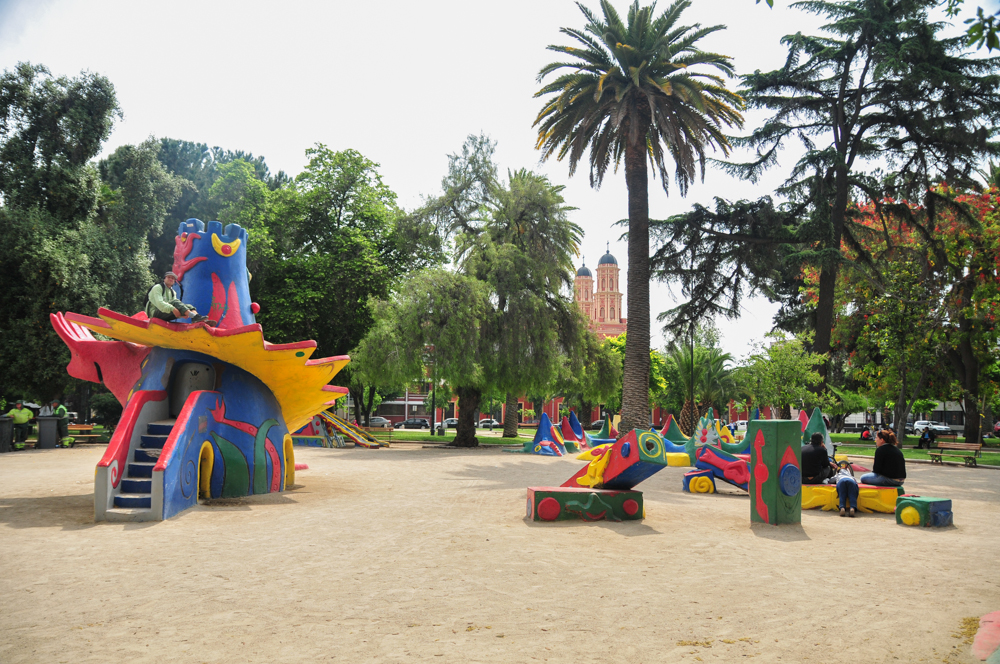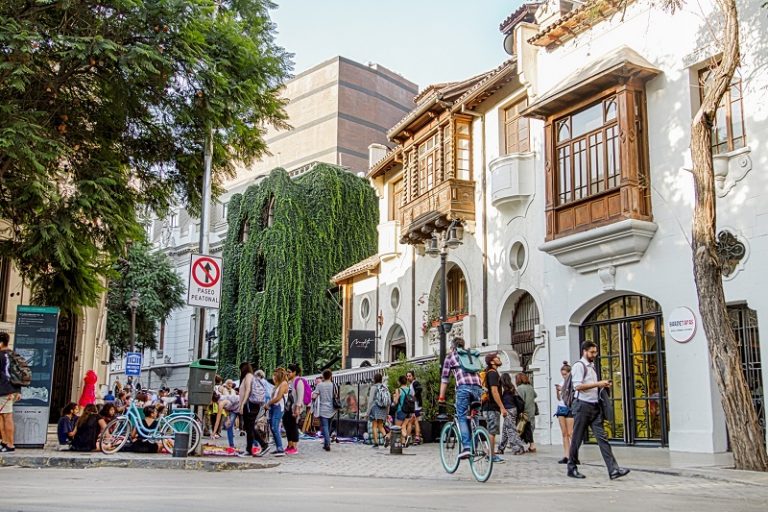By Tracey Chandler and Ana María Valenzuela for ContactChile Traduction by Nicole Reisen
Barrio Brasil is a neighbourhood located in the western sector of Santiago. It is certainly one of the most traditional residential areas of the capital. Walking its streets you can admire its architecture and patrimonial history which allows you to escape from this otherwise hectic and fast-paced city for an afternoon.
It was once the neuralgic centre of the wealthy upper-class of 19th century Chilean society. When Calle Brasil and Plaza Brasil were built, in honour of the Brazilian people and the Brazilian embassy, more and more large houses were built too and wealthy elite families came to live their golden years here. Evidence of this glamorous past is the still existing mix of neo-gothic and neo-classical architectural styles.
However, since the 1940s, the appearance of new apartment houses in the eastern sector of the capital has led to a slow but steady departure of the wealthy upper class and today Barrio Brasil is far from being glamorous. Since then, the neighbourhood has been reinventing itself and acquiring a new personality, currently defining itself as a cultural and rather bohemian sector.

Plaza Brasil
The neighbourhoods central square, Plaza Brasil, is one of the best open spaces in the city to spend an afternoon resting on the lawn, reading a book or sharing a snack or picnic with friends.
It’s a place where you certainly won’t get bored, because there is a lot to observe. It is common, for example, to come across travelling circus performers practicing their skills or preparing a show. Groups of “yogis” practice their flow underneath the trees or you can observe people practicing Capoeira or Tai Chi. If you’re lucky you might catch a musician spending the afternoon rehearsing with a colleague.
Families bring their children to enjoy the swings on the playground in the centre of the square. Some weekends there is also some kind of flea market, where you can exchange clothes or other items that you no longer use for things that will serve you.

Bars, restaurants and nightlife
Avenida Brasil is full of bars and restaurants that serve a wide range of cocktails for all tastes. There are great bars like “Cosmopolitan“, “Springfield” or “La Remolineda” that tend to offer reduced prices during “happy hour”, with 2 for 1 offers, which is usually start between 5:00 or 6:00 in the afternoon and go on until 9:00 at night.
These bars are excellent places to hang out during the summer months, as they have many tables outdoors and the atmosphere is bustling and pleasant. The street, with its enormous palm trees, which give it a Caribbean flair, is quite beautiful, despite being a main street.
If you are not a party goer this is still an interesting place because you can eat well here. The recent boom of restaurants and new cafeterias accompanied by its bohemian atmosphere makes a visit to this neighbourhood worthwhile. At “Juan y Medio” meat lovers get their money’s worth and the cafeteria “La Huérfana” is the place to be for vegetarians. There are only organic products used here. Vegans go to the cafeteria “Veg & Bake“. Despite the change, there are still cafés and bakeries with authentic Brazilian cuisine, such as the “Bolos Brasil“, where you can taste “café da manhá”, “brigadeiros” or cheese bread among other delicacies.

Neighbouring Barrio Yungay
Barrio Brasil is only two blocks away from the Barrio Yungay. Both their history and geography unite and mix them, so they are usually visited together, but as a tip, Barrio Yungay is much bigger and therefore it is worth exploring the two neighbourhoods individually.
Barrio Yungay is named after the victory obtained by the Chilean army in the Battle of Yungay in 1839, in the war against the Peru-Bolivian Confederation.
Among the main attractions of this neighbourhood are several of Santiago’s most important museums such as the Museum of Contemporary Art, the National Museum of Natural History, the Santiago Railway Museum and the Museo Artequín. There are also some very traditional schools like the Barros Arana National Boarding School and the Liceo Amunátegui located here. Not to forget the Quinta Normal Park, one of the most visited places next to Yungay Square, where the monument to the “Chilean Roto” is to be found.
The walls of Barrio Yungay are covered with some of Santiago’s most creative and politically associated graffiti, and the buildings that are not covered with them are just as fascinating: the colours are cold, soft, pastel and most buildings are single-storey. Trees line the streets, buses pass rarely and a real neighbourhood life is being lived, where people go to traditional bakeries, tailors’ shops, and small businesses instead of warehouses.
While you stroll through the streets of Barrio Yungay you will find a peaceful silence that is hard to find in most other sectors of Santiago. If you’re walking, a good starting point to visit either of these two neighbourhoods is the Cumming Metro on Line 5. From where you will be able to go either way and simply enjoy.
Have you visited any of these neighborhoods or would you like to? What do you think should be next? Tell us in the comments!


